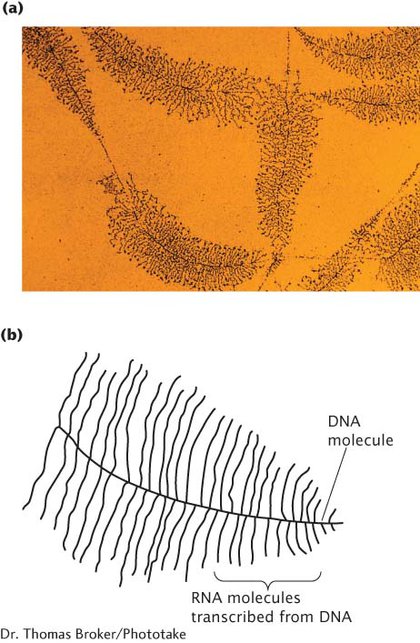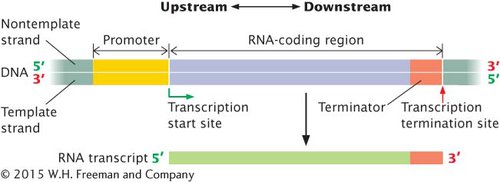The Template
In 1970, Oscar Miller, Jr., Barbara Hamkalo, and Charles Thomas used electron microscopy to examine cellular contents and demonstrate that RNA is transcribed from a DNA template. They saw Christmas-

264
THE TRANSCRIBED STRAND The template for RNA synthesis, as for DNA synthesis, is a single strand of the DNA double helix. Unlike replication, however, the transcription of a gene takes place on only one of the two nucleotide strands of DNA (Figure 10.4). The nucleotide strand used for transcription is termed the template strand. The other strand, called the nontemplate strand, is not ordinarily transcribed. Thus, within a gene, only one of the nucleotide strands is normally transcribed into RNA (there are some exceptions to this rule). Although only one strand within a single gene is normally transcribed, different genes may be transcribed from different strands, as illustrated in Figure 10.5.


During transcription, an RNA molecule that is complementary and antiparallel to the DNA template strand is synthesized (see Figure 10.4). The RNA transcript has the same polarity and base sequence as the nontemplate strand, except that it contains U rather than T.  TRY PROBLEM 16
TRY PROBLEM 16
CONCEPTS
Within a single gene, only one of the two DNA strands, the template strand, is usually transcribed into RNA.
 CONCEPT CHECK 2
CONCEPT CHECK 2
What is the difference between the template strand and the nontemplate strand?
The template strand is the DNA strand that is transcribed into an RNA molecule, whereas the nontemplate strand is not transcribed.
THE TRANSCRIPTION UNIT A transcription unit is a stretch of DNA that encodes an RNA molecule and the sequences necessary for its transcription. How does the complex of enzymes and proteins that performs transcription—
Included within a transcription unit are three critical regions: a promoter, an RNA-

The second critical region of the transcription unit is the RNA-
265
Molecular biologists often use the terms upstream and downstream to refer to the direction of transcription and the locations of nucleotide sequences surrounding the RNA-
When DNA sequences are written out, often the sequence of only one of the two strands is listed. Molecular biologists typically write the sequence of the nontemplate strand because it will be the same as the sequence of the RNA transcribed from the template strand (with the exception that U in RNA replaces T in DNA). By convention, the sequence on the nontemplate strand is written with the 5′ end on the left and the 3′ end on the right. The first nucleotide transcribed (the transcription start site) is numbered +1; nucleotides downstream of the start site are assigned positive numbers, and nucleotides upstream of the start site are assigned negative numbers. So, nucleotide +34 would be 34 nucleotides downstream of the start site, whereas nucleotide −75 would be 75 nucleotides upstream of the start site. There is no nucleotide numbered 0.
CONCEPTS
A transcription unit is a stretch of DNA that encodes an RNA molecule and the sequences necessary for its proper transcription. Each transcription unit includes a promoter, an RNA-